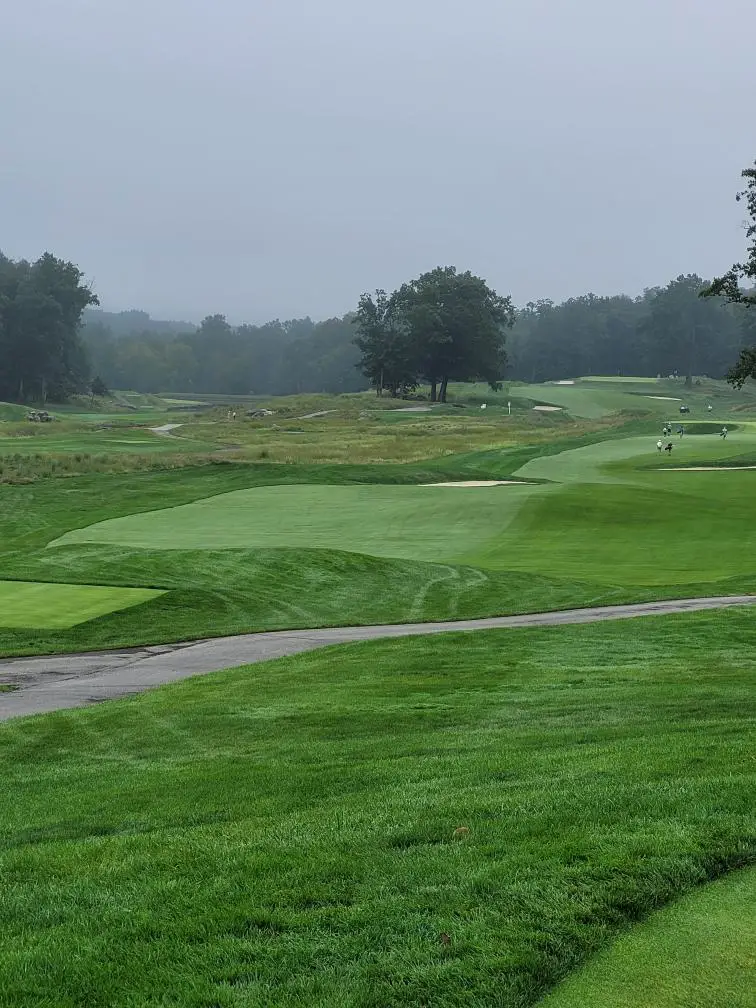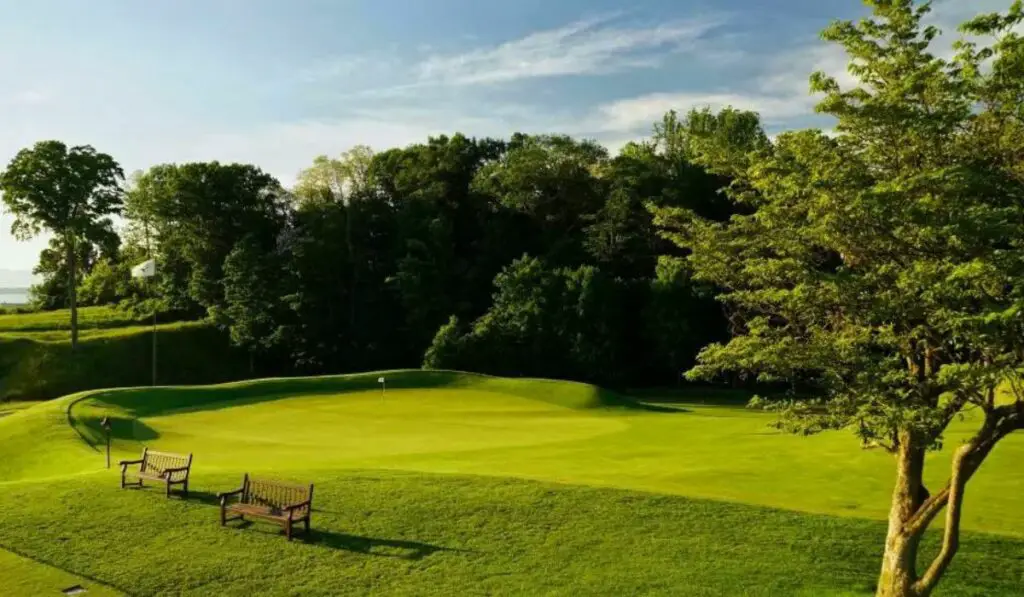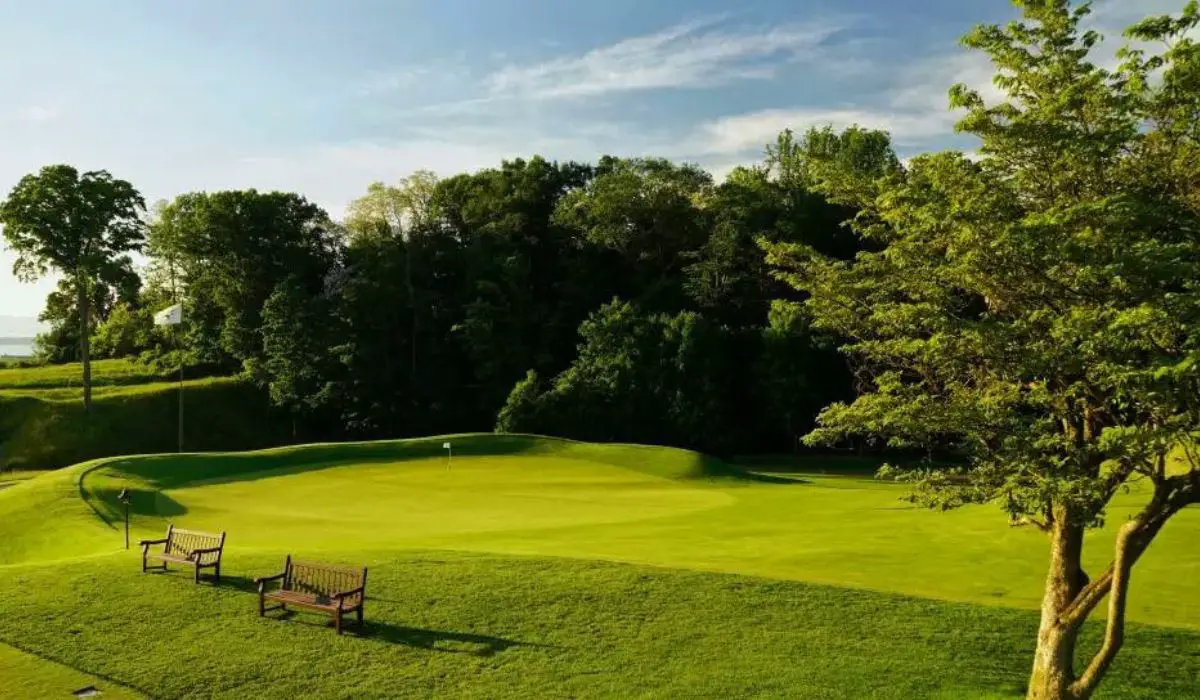If you are half as into golf as I am, your Instagram algorithm without a doubt has shown you pictures of Sleepy Hollow Country Club on your explore page.
This Charles Blair McDonald masterpiece overlooking the Hudson River nestled in Westchester County, NY was a place on my bucket list I would have given my left leg to play if I meant that I could still successfully get my ball around without it.
Almost on a daily basis, I would open up Instagram to find pictures of the famous “Short” 16th, “Eden” 3rd, or “Punchbowl” 15th. As a self-proclaimed golf nerd and architecture junkie, Sleepy Hollow Country Club seemed like a museum of golf design riddled with McDonald’s famous template-style designs.
Given the circumstances, I believed that Sleepy would forever remain a distant place confined to my iPhone, beyond the possibility of experiencing it firsthand as originating from South Carolina, with no personal connections to its members.
That was until the USGA announced that it would be hosting the 2023 United States Mid Amateur Championship.
What is the US Mid Amateur?
The US Mid Amateur Championship is one of the most prestigious amateur golf tournaments in the world.
Held annually by the USGA, it brings together 264 of the top mid-amateur (25+ years old) players to compete in a grueling 162-hole stroke and match play event.
The winner earns invites to the Masters and US Open.
As a passionate golfer and recent college graduate, qualifying for the 2023 Mid Am at the famed Sleepy Hollow Country Club in Scarborough, New York was a dream.
This Charles Blair Macdonald-designed masterpiece, with recent renovations by Gil Hanse, has been on my bucket list for years.
Getting the chance to test my skills against the nation’s best amateurs on Sleepy Hollow’s incredible template holes overlooking the Hudson River still feels unreal.
Here’s my journey to make it into the championship and compete on one of America’s ultimate inland links courses.
Qualifying at Benvenue Country Club
As a 2021 college graduate and full-time 9-5 insurance agent, the Mid Amateur circuit is what an ex-college player like myself lives for.
This year was my first year eligible to compete in the championship and when I saw that it was being held at Sleepy Hollow, my excitement grew even more.
Being in the working world had really put a damper on my golf resume so if I wanted to earn the right to compete in this year’s championship and walk the majestic fairways of Sleepy, I would have to qualify.
The site that I chose to earn my spot was Benvenue Country Club, a mostly untouched Donald Ross Gem located in Rocky Mount, North Carolina.
I teed it up on a July morning knowing I needed to have a good day as only three qualifying spots were available out of 73 players.
After three putting my eighteenth hole in regulation I found myself sitting at one under par in a tie for third with about an hour of players left to come in. All I could hope for was a playoff and the next hour was agonizing as group after group came in somehow shooting higher.
After all the scores came in it turned out I was in a 3 for 1 playoff to earn my spot, and let me tell you, the next 15 minutes were a wild ride.
Not only was I playing for a spot in a coveted national championship, but I was also playing for my one chance to play at Sleepy Hollow.
After watching both my competitors stripe their ball down the fairway I nervously held on to my drive blocking it up against the face in the left fairway bunker.
I know I was nervous and apparently, the other two guys were too because they both missed the green, one short and one long, while I roped hooked an eight iron out of the sand over to a neighboring hole, yeah it was about 40 yards right, not good.
Sitting on a downslope shortsied from 40 yards I knew I still had a chance, but it would require perfect contact. Being the first to play I mustered up a 1 in 5 shot and clipped my ball perfectly to 5 feet of the hole that took one hop and stopped.
After watching the other two guys in my group fail to get up and down I tensely brushed in the five-footer to secure my spot at Sleepy. If it sounds like a rollercoaster, you should have seen it in person.
Off to meet the headless horseman as Sleepy…
The Woodlea Clubhouse

Scale is the best way to describe this historic club overlooking the famed Hudson River and it begins with the clubhouse. I am not typically a clubhouse snob, but this week that was a different story.
Constructed in 1892 by Colonel Elliot Fitch Shephard, founder of the NY Bar Association, this Vanderbilt mansion features 140 rooms and painstakingly handcrafted details such as the ones shown below.

In 1910, Frank Vanderlip and William Rockefeller acquired the mansion, and the following year, a board of directors established Sleepy Hollow Country Club.
This board included prominent figures such as John Jacob Astor IV, Cornelius Vanderbilt III, and Edward Julius Berwind, among others.
It wasn’t until a few years later that the Woodlea Clubhouse became the center of the club as the original course featured a small golf house that sat by what now is the second tee.
Making the decision to make this mansion the focal point of the club was the perfect choice as it truly gives you a glimpse of what is to come.
Playing Sleepy Hollow
The words on this page simply do not do Sleepy Hollow Country Club Justice as it is truly a work of art. Originally designed by legendary architect Charles Blair McDonald and later touched by the likes of A.W. Tilinghast and more recently Gil Hanse; Sleepy Hollow feels like you stepped on a course in the 1920s.
As a golf course architecture junkie, I felt like a ten-year-old on Christmas morning playing McDonald’s template holes recently reimagined by Hanse and George Bahto, a McDonald design expert.
The First “Leven” Hole – A Template to Start at Sleepy Hollow
Out of the gate teeing off from an elevated box from the Woodlea clubhouse’s steps you can see the first template of the day.
Sleepy starts you out with a mid-length par 4 “Leven” template and is one of the best renditions of this hole in the world.
With a large mound guarding the front right section of the green, players are forced to take on the fairway bunker and out of bounds down the left-hand side to get a clear view of the green.
Walking up to the first green, players get a true taste of the massive putting surfaces to come as Sleepy Hollow’s greens are some of the largest in the States.
Hanse and his team reshaped the green during the most recent renovation to create sections and lots of interesting hole locations.

Teeing Off With a View at the Picturesque 2nd “Alps”
The second hole quickly gets you to the pinnacle views of the nearby Hudson River and gives you a glimpse of what is to come.
A short par 4, measuring only 370 yards from the championship tee has players playing straight up a verticle ridge leaving a wedge or short iron to a very spinny green that plays more difficult than it originally appears.
Glimpsing the Hudson River From the Elevated 3rd Green “Eden”
Fit into the side of the hill seamlessly like a hand in a glove. The third starts what will be a quartet of amazing threes. Hanse and Bahto added all kinds of humps and hollows in this green that make feeding your ball close the hole a lot of fun.
Missing the hollow that the pin is in, however, makes your hopes of making a three dismal. I was out of position on this green and had to make a ten-foot putt to save my par.
Views of the other great template holes and the Hudson River valley abound on this green which is a trend in this amazing section of the course.
Players are also greeted with their first view of Sleepy’s famous haunted bridge.

Navigating the Blind Shots on Holes 4 and 5
The fourth and fifth, although great holes are a little bit of an intermission in the template action. Both feature blind tee shots that follow the natural untouched shape of the land.
These two mid-length par fours that play shorter than their yardages give players a chance to make a birdie before entering one of the most challenging stretches on the course.
The view from the fifth fairway may be the best one on the course as well!

The Quirky, Short Par-5 6th Hole Along the River
Perhaps the most interesting par 5 I have ever played, the sixth at Sleepy Hollow is one of the few McDonald originals still remaining.
Measuring at just 470 yards this had to be one of the shortest par 5s in USGA championship history, however, it still provided plenty of challenge.
Starting with a blind tee shot to a massive two-tiered fairway, players have to carry their drive some 250 yards to get up top to have a clear shot to the putting surface.
In addition to this challenge, longer players are forced to take on the dogleg of the hole as the upper fairway runs out into a hazard on the left and drops down into a thick forest on the right.

After successfully navigating the tee shot, the long iron approach visual is obscured by the infamous principles nose bunker positioned out of play for good tee shots but challenges players by hiding part of the green.
Ultimately, the sixth hole gives you one more birdie opportunity as the course heads back inland away from the river to a very challenging stretch.
Looking back, the view from the tee box also doesn’t get much better as you get a clear view of holes 2, 3, and 16.
The Challenging Par 3 – 7th Hole “Redan”
Starting a brutal stretch of holes, the seventh gives you a chance with a good strategy and well-struck iron.
This 220-yard par three features two distinct ways to get your ball onto the putting surface; take a direct route, or take less club and use the left hill to chase your ball up.
Playing to a far-right-hole location, my round at Sleepy is a nice case study of what not to do. Instead of trying to fly a long iron at the pin, I made an effort to use the Slope McDonald had given me to safely get my ball to where it needed to be.
Taking aim at the slope with what I thought was a perfect swing air mailed the hill leaving me with an almost impossible up and down.
Learn from my mistakes here and if you ever find yourself on the seventh at Sleepy or a template redan, take less club and if you are going to use the slope make sure you actually use it!
Surviving the Tough Par-4 8th “Road Hole”
The 483-yard eight-hole requires two great golf shots if you intend on walking off with a four similar to the 17th at Saint Andrews.
Sitting in the direct center of the property more stellar views of the course can be seen on the eighth from a recent tree removable from the Hanse team.
Players can clearly see glimpses of over half the holes at Sleepy standing on this tee making it almost difficult to focus.
Focus is what you need however on the eight as missed fairways in the thick rough will most certainly result in a layup and mishit long iron seconds will find their way into the deep road hole bunker or will be rejected off of the large false front.
Par at the eighth will have you picking up shots on your competition as this hole played as the hardest for the Championship.

Uphill Challenge on the 9th “Knoll” Hole
The fantastic surrounding views of the course abound on the ninth and a good drive will set you up with a blind short to mid-iron second shot to a manageable two-tiered green.
Any miscue off of the tee at the ninth will leave the player scrambling as rough in front of the green leaves you little hope of running up any shots.
Flow is a theme that you will find at Sleepy Hollow and you will see just that here as the back of the green rides right into the tenth tee both making this a center for attention during championships with first and 10th tee starts.
The Scenic Island Green Par-3 10th Hole
When Tillinghast renovated Sleepy Hollow in the mid-1900s, he felt that the course needed at least one hole with a large body of water.
He and his team created what now is the tenth which is a short par three featuring two greens in one thanks to a large ridge. I found myself on the wrong side of this ridge which resulted in a comfy three-put bogey to start my championship.

As you can see in the picture below, Hanse and his team added large hogs back funneling off of the back hill that separates back right-hole locations from the rest of the putting surface.
Being the only non-template three par of the course, the tenth does not disappoint and gives players a small birdie opportunity with a well-struck short iron to get shots back that were lost on seven through nine.
Elevated 11th Green Repels Shots Hit Short
Eleven through fourteen at Sleepy Hollow gives a nice blend of challenge and opportunity in the middle of the inward nine.
These four holes have a trend of large fairways and challenging greens as players work to get back to the pinnacle of the golf course.
Eleven starts you out with a generous fairway and then has you play to the first of three extremely elevated green that will repel balls back down some forty or fifty yards for anything coming up short.
This middle length par four does give a nice opportunity for three with a very flat green but any miscue will most likely end in a bogey.
The New Par 5 – 12th Hole “Double Plauteu”
During the most recent Hanse renovation, the twelfth is one of the most drastic changes on the property. The old design played as a par four and had players hitting their second shots up to the right to a blind green.
The now, short 530-yard par five plays as a dogleg left over an added creek to a dramatic double plateau green that much like the 11th will repel mishits some forty or fifty years down its front side.
This hole also offers a generous fairway but thick gunch on the left and heavy rough on the right will make what should be an easy birdie into a possible bogey or worse.
The rocky Westchester terrain frames this hole perfectly and I think that the Gil Hanse original would get the seal of approval from McDonald.
The Thirteenth and Fourteen
If there is a weak point to Sleepy Hollow, it comes at the thirteenth and fourteenth. These holes both feature a generous fairway with a cross bunker cutting in approximately 290 yards off the tee.
The green complexes here make up for their repetitiveness as the green on thirteen just like its two predecessors, repels shots some fifty yards off its front, and the green on fourteen features three vertical spines much like the tenth, forcing players to hit an accurate short iron.
Funneling Drives on the 15th “Punchbowl”
My personal favorite hole that I have ever played, is the punchbowl! Also, it doesn’t hurt this was my only birdie at Sleepy in the championship.
This par four turned par five for the championship plays back toward the Hudson River and brings us back to where we began with the stellar views from holes two through six.

Players are faced with a nervous tee shot to have the opportunity to launch their long iron in the funnel that is the green, finding the fairway is a must. The second shot features a mid to long iron over a ridge to a blind green that funnels your ball on no matter where you hit it.
An aiming flag with the Sleepy Hollow logo is featured on the back fringe with a perfect line to let the bowl do its work.
The excitement of walking over the ridge to see how close your ball finished to the cup is palpable and is something that I have never quite experienced.
Between the scenic views that are regained of the Hudson and the excitement of using slopes to feed your ball in, the fifteen is truly amazing.
World-Famous 16th “Short” Hole Lives Up to Hype
If you like golf and have social media, you have for sure seen pictures of the sixteenth at Sleepy Hollow.
This 140-yard par three may be the best “Short” template in the world as it features world-class views, challenges, and opportunities.
Seeing this thumbprint green in person was eye-opening as there was much more slope than I ever could imagine from the pictures.
Fortunately, in the stroke play portion of the championship, the USGA was kind to us and gave a hole location in the thumbprint of the green.
With any other hole location, this majestic hole can turn into a challenge in a hurry.

Last Chance at Birdie on the Short 17th
Offering a tee shot that plays some thirty yards downhill, you are given your last big view at Sleepy as you work your way back toward the clubhouse.
Originally, McDonald built the seventeenth as a par five that played fifty yards longer than it does today but when the club sold land behind the tee it was shortened to what we see now.
The seventeenth gives you a great opportunity for birdie as drives that find the fairway leaves players with a wedge or short iron to a large but flat green.
Going into the challenging eighteenth, getting a good look here is pivotal to ending your round in style.
I fortunately gave myself that look hitting PW to five feet only to miss the putt which you will learn later put a big damper on my championship hopes this year.
Classic Finishing Hole Showcases Sleepy Hollow’s Scale – The Eighteenth
A culmination of everything that you have been through during your round at Sleepy Hollow is the eighteenth.
The eighteenth is framed by a bunker out of the play off the tee, a large Oak tree that has been around since the club’s inception, a cross bunker some forty yards short of the green, a steep false front, half punchbowl green, and the clubhouse patio as the hole walks players up the hill to the finish.
This hole has scale as Hanse likes to say. It takes your eye from the tee box and makes it easy to guide up the hill to the clubhouse.
Don’t let the amazing look of this hole fool you however, it is challenging to say the least. Any miscue off the tee will surely result in a layup for your second and any pin positioned near the false front can cause havoc for approach shots coming up shy.
The eighteenth at Sleepy is an amazing finish to what was an amazing day.

My Bid for Mid Am Glory Falls Just One Shot Short
Contested over two rounds of stroke play and six rounds of match play, the US Mid Amateur was a dream to play in.
My game showed up in order when I arrived in New York and I knew I had a good chance of making it into the top 64 over stroke play which would get me to the match play portion.
I played Sleepy in the first round and the stroke play co-host Fenway Golf Club in the second round. My ball striking throughout was some of the best I have ever hit it in my life but a bawky putter unfortunately brought me to four over for the 36 holes to miss out on match play by one shot.
Nonetheless, my time at Sleepy Hollow was amazing. Hanse and his team have done a fabulous job bringing back this timeless gem to the routing and layout that it deserves. From the Woodlea Clubhouse, the perfectly recreated template holes, and the breathtaking views of the Hudson River, Sleepy Hollow Country Club was truly a dream to play.
Here’s a nod to Charles Blair McDonald, A.W. Tillinghast, and Gil Hanse / George Bhato for putting together a piece of art in Westchester County New York.




